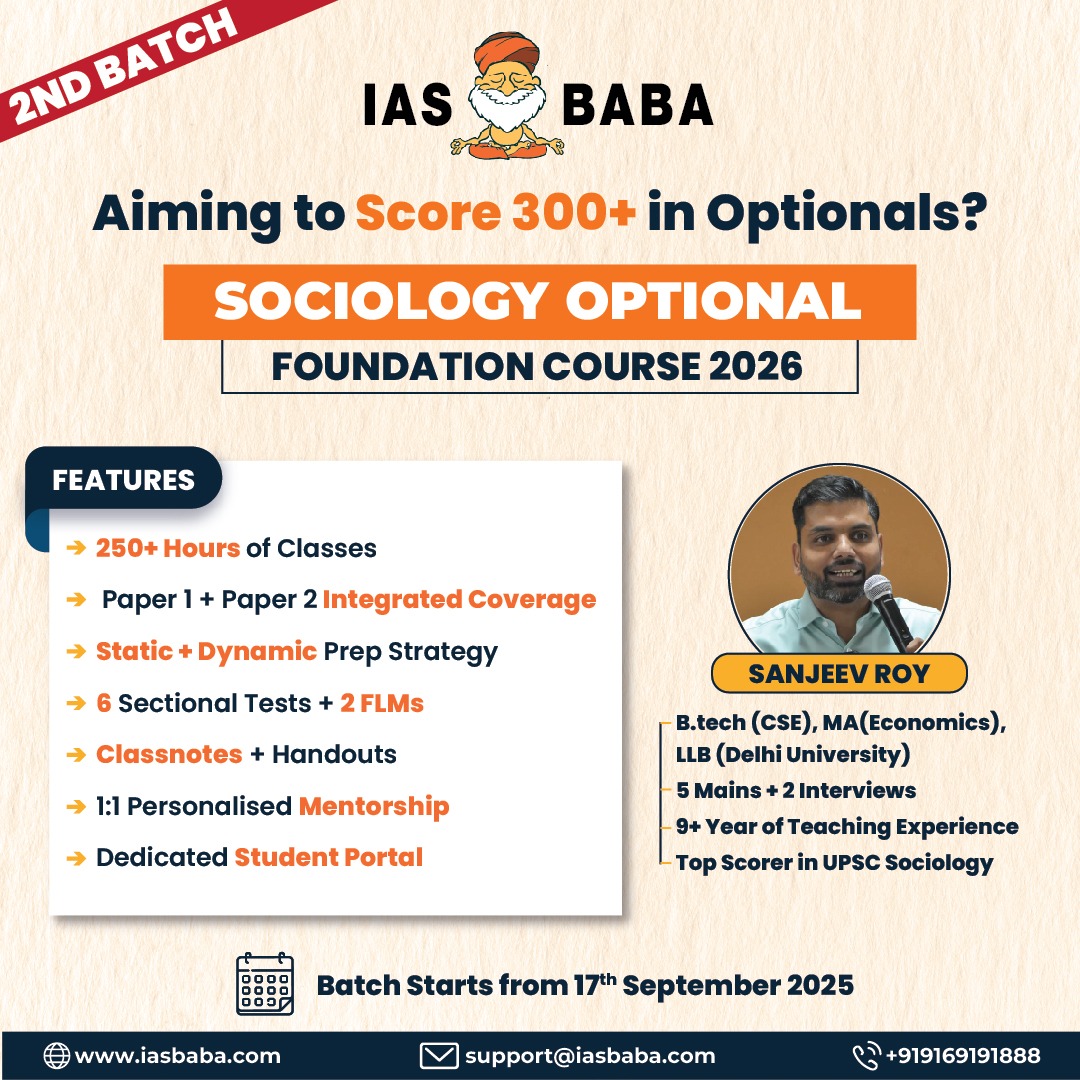IASbaba Daily Prelims Quiz
For Previous Daily Quiz (ARCHIVES) – CLICK HERE
The Current Affairs questions are based on sources like ‘The Hindu’, ‘Indian Express’ and ‘PIB’, which are very important sources for UPSC Prelims Exam. The questions are focused on both the concepts and facts. The topics covered here are generally different from what is being covered under ‘Daily Current Affairs/Daily News Analysis (DNA) and Daily Static Quiz’ to avoid duplication. The questions would be published from Monday to Saturday before 2 PM. One should not spend more than 10 minutes on this initiative.
Gear up and Make the Best Use of this initiative.
Do remember that, “the difference between Ordinary and EXTRA-Ordinary is PRACTICE!!”
Important Note:
- Don’t forget to post your marks in the comment section. Also, let us know if you enjoyed today’s test 🙂
- After completing the 5 questions, click on ‘View Questions’ to check your score, time taken, and solutions.
Test-summary
0 of 5 questions completed
Questions:
- 1
- 2
- 3
- 4
- 5
Information
To view Solutions, follow these instructions:
- Click on – ‘Start Test’ button
- Solve Questions
- Click on ‘Test Summary’ button
- Click on ‘Finish Test’ button
- Now click on ‘View Questions’ button – here you will see solutions and links.
You have already completed the test before. Hence you can not start it again.
Test is loading...
You must sign in or sign up to start the test.
You have to finish following test, to start this test:
Results
0 of 5 questions answered correctly
Your time:
Time has elapsed
You have scored 0 points out of 0 points, (0)
| Average score |
|
| Your score |
|
Categories
- Not categorized 0%
| Pos. | Name | Entered on | Points | Result |
|---|---|---|---|---|
| Table is loading | ||||
| No data available | ||||
- 1
- 2
- 3
- 4
- 5
- Answered
- Review
-
Question 1 of 5
1. Question
-
Consider the following statements:
Statement I: Quantum tunnelling allows particles to pass through potential energy barriers that they classically should not be able to cross.
Statement II: Quantum tunnelling explains the phenomenon of alpha decay in radioactive nuclei.
Statement III: Quantum tunnelling enables the working of semiconductor devices such as tunnel diodes and scanning tunnelling microscopes.
Which one of the following is correct in respect of the above statements?
Correct
-
Solution: (a)
Explanation:
- It describes the core concept of quantum tunnelling — a particle’s ability to penetrate a potential barrier due to its wave-like nature. Hence Statement I is correct
- Alpha decay occurs when an alpha particle “tunnels” through the nuclear potential barrier. Hence Statement II is correct
- Devices like tunnel diodes and scanning tunnelling microscopes operate on the principle of quantum tunnelling. Hence Statement III is also correct
- Both II and III exemplify and hence explain Statement I.
Incorrect
-
Solution: (a)
Explanation:
- It describes the core concept of quantum tunnelling — a particle’s ability to penetrate a potential barrier due to its wave-like nature. Hence Statement I is correct
- Alpha decay occurs when an alpha particle “tunnels” through the nuclear potential barrier. Hence Statement II is correct
- Devices like tunnel diodes and scanning tunnelling microscopes operate on the principle of quantum tunnelling. Hence Statement III is also correct
- Both II and III exemplify and hence explain Statement I.
-
-
Question 2 of 5
2. Question
A ‘Supermoon’ occurs when —
Correct
-
Solution: (c)
Explanation:
- A Supermoon occurs when the Full Moon coincides with the Moon’s perigee (the point in its elliptical orbit closest to Earth).
- The Moon appears up to 14% larger and 30% brighter than a typical Full Moon.
Incorrect
-
Solution: (c)
Explanation:
- A Supermoon occurs when the Full Moon coincides with the Moon’s perigee (the point in its elliptical orbit closest to Earth).
- The Moon appears up to 14% larger and 30% brighter than a typical Full Moon.
-
Question 3 of 5
3. Question
-
Consider the following statements:
-
Central Bank Digital Currency (CBDC) is a legal tender issued by the Reserve Bank of India in a digital form, equivalent in value to physical currency.
-
Unlike cryptocurrencies, CBDC operates on a decentralized blockchain network independent of the central bank’s control.
Which of the statement(s) given above is/are incorrect?
Correct
-
Solution: (b)
Explanation:
- CBDC is the digital form of fiat money issued by the RBI, with the same legal status as paper currency. India has launched e₹-R (retail) and e₹-W (wholesale) pilots under this framework. Hence Statement 1 is correct
Unlike cryptocurrencies, CBDC is centrally regulated and backed by the RBI, not decentralized. It may use distributed ledger technology (DLT) selectively, but governance remains centralized. Hence Statement 2 is incorrect
Incorrect
-
Solution: (b)
Explanation:
- CBDC is the digital form of fiat money issued by the RBI, with the same legal status as paper currency. India has launched e₹-R (retail) and e₹-W (wholesale) pilots under this framework. Hence Statement 1 is correct
Unlike cryptocurrencies, CBDC is centrally regulated and backed by the RBI, not decentralized. It may use distributed ledger technology (DLT) selectively, but governance remains centralized. Hence Statement 2 is incorrect
-
-
Question 4 of 5
4. Question
-
Consider the following statements about the Periyar Tiger Reserve:
-
It forms part of the Cardamom Hills and the Pandalam Hills of the southern Western Ghats.
-
The Periyar River originates within the reserve and flows northward to join the Bharathapuzha River.
-
It is an important habitat for both Nilgiri tahr and the lion-tailed macaque.
How many of the statement(s) given above is/are correct?
Correct
-
Solution: (b)
Explanation:
- Periyar Tiger Reserve is located in Kerala’s Idukki and Pathanamthitta districts, covering parts of the Cardamom Hills and Pandalam Hills, both belonging to the southern Western Ghats. Hence Statement 1 is Correct
- The Periyar River indeed originates inside the reserve (near Sivagiri), but it flows westward into Vembanad Lake, not northward or into the Bharathapuzha River. Hence Statement 2 is Incorrect
The reserve supports endemic species like the Nilgiri tahr and lion-tailed macaque, both key indicators of Western Ghats ecology. Hence Statement 3 is Correct
Incorrect
-
Solution: (b)
Explanation:
- Periyar Tiger Reserve is located in Kerala’s Idukki and Pathanamthitta districts, covering parts of the Cardamom Hills and Pandalam Hills, both belonging to the southern Western Ghats. Hence Statement 1 is Correct
- The Periyar River indeed originates inside the reserve (near Sivagiri), but it flows westward into Vembanad Lake, not northward or into the Bharathapuzha River. Hence Statement 2 is Incorrect
The reserve supports endemic species like the Nilgiri tahr and lion-tailed macaque, both key indicators of Western Ghats ecology. Hence Statement 3 is Correct
-
-
Question 5 of 5
5. Question
-
Consider the following statements:
Statement I: The International Court of Justice (ICJ) settles legal disputes between States and gives advisory opinions on legal questions referred by authorized UN organs and specialized agencies.
Statement II: Only UN member states have the right to appear before the ICJ in contentious cases.
Statement III: Decisions of the ICJ are binding on all members of the United Nations irrespective of whether they are parties to the case or not.
Which one of the following is correct in respect of the above statements?
Correct
-
Solution: (c)
Explanation:
- It correctly describes the dual functions of the ICJ — contentious jurisdiction (disputes between states) and advisory jurisdiction (legal opinions). Hence Statement I is Correct
- Only states (and not individuals, corporations, or NGOs) can be parties in contentious cases before the ICJ. This directly supports Statement I. Hence Statement II is Correct
- ICJ judgments are binding only on the parties to the case, not on all UN members (Article 59 of the ICJ Statute). Hence Statement III is Incorrect
Therefore, Statement II alone is correct and explains Statement I.
Incorrect
-
Solution: (c)
Explanation:
- It correctly describes the dual functions of the ICJ — contentious jurisdiction (disputes between states) and advisory jurisdiction (legal opinions). Hence Statement I is Correct
- Only states (and not individuals, corporations, or NGOs) can be parties in contentious cases before the ICJ. This directly supports Statement I. Hence Statement II is Correct
- ICJ judgments are binding only on the parties to the case, not on all UN members (Article 59 of the ICJ Statute). Hence Statement III is Incorrect
Therefore, Statement II alone is correct and explains Statement I.
-
- Current Affairs Quiz, IAS Daily Current Affairs Quiz, IAS UPSC Current Affairs Quiz, IAS UPSC Prelims Quiz, IASbaba's Current Affairs Prelims Quiz, IASbaba's Daily Quiz, IASbaba's UPSC Quiz, Prelims Current Affairs Quiz, UPSC Current Affairs Quiz, UPSC Current Affairs Quiz IASbaba, UPSC Daily Current Affair Quiz, UPSC IAS Daily Quiz













